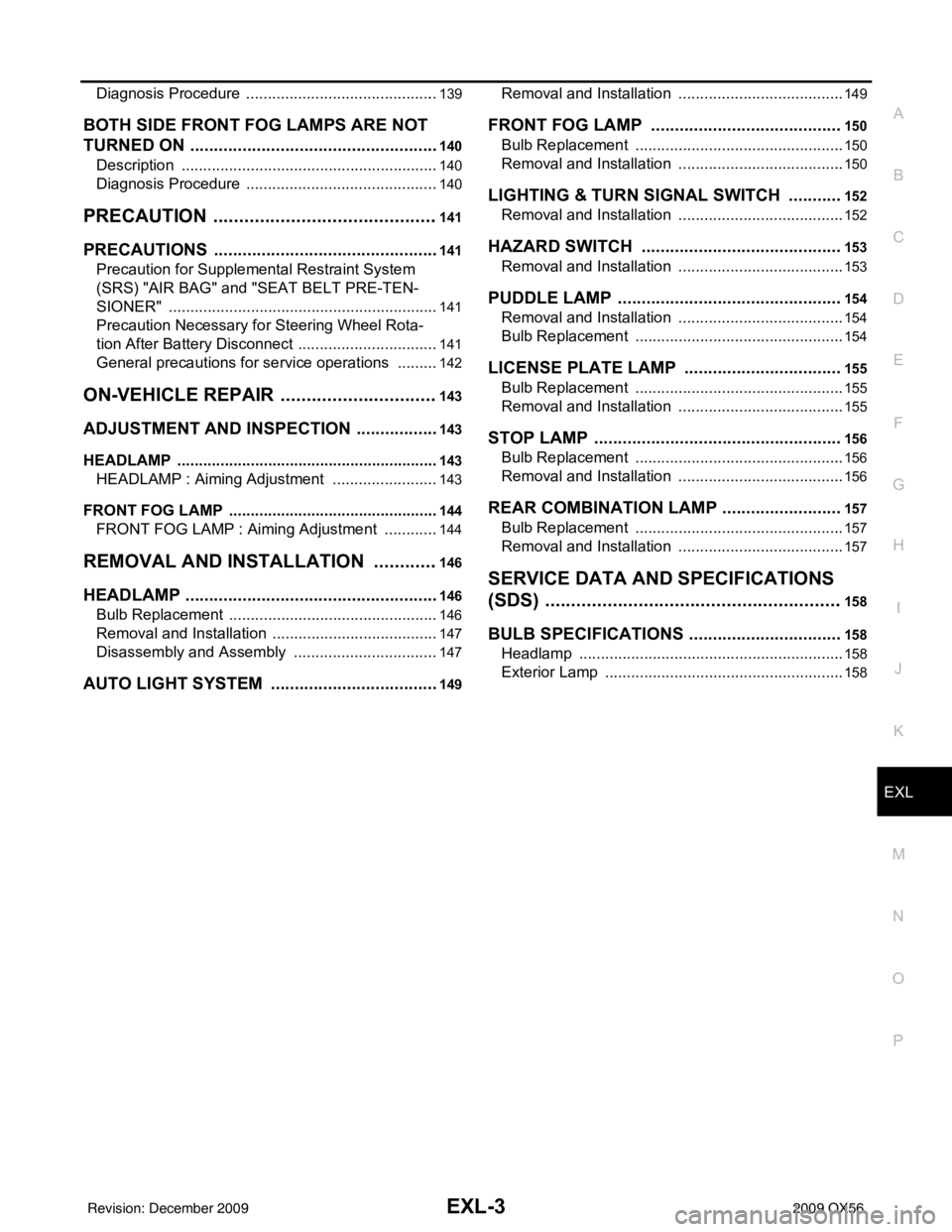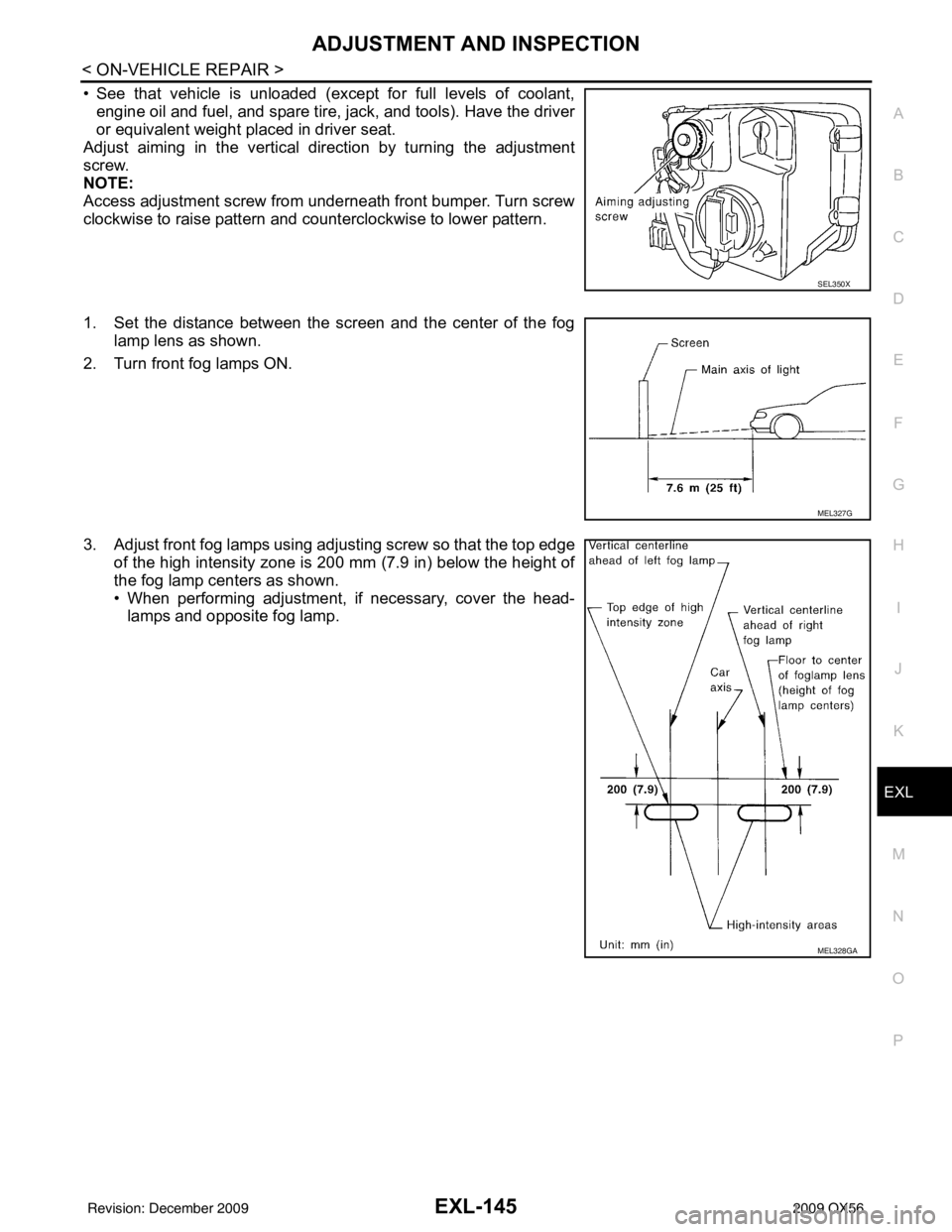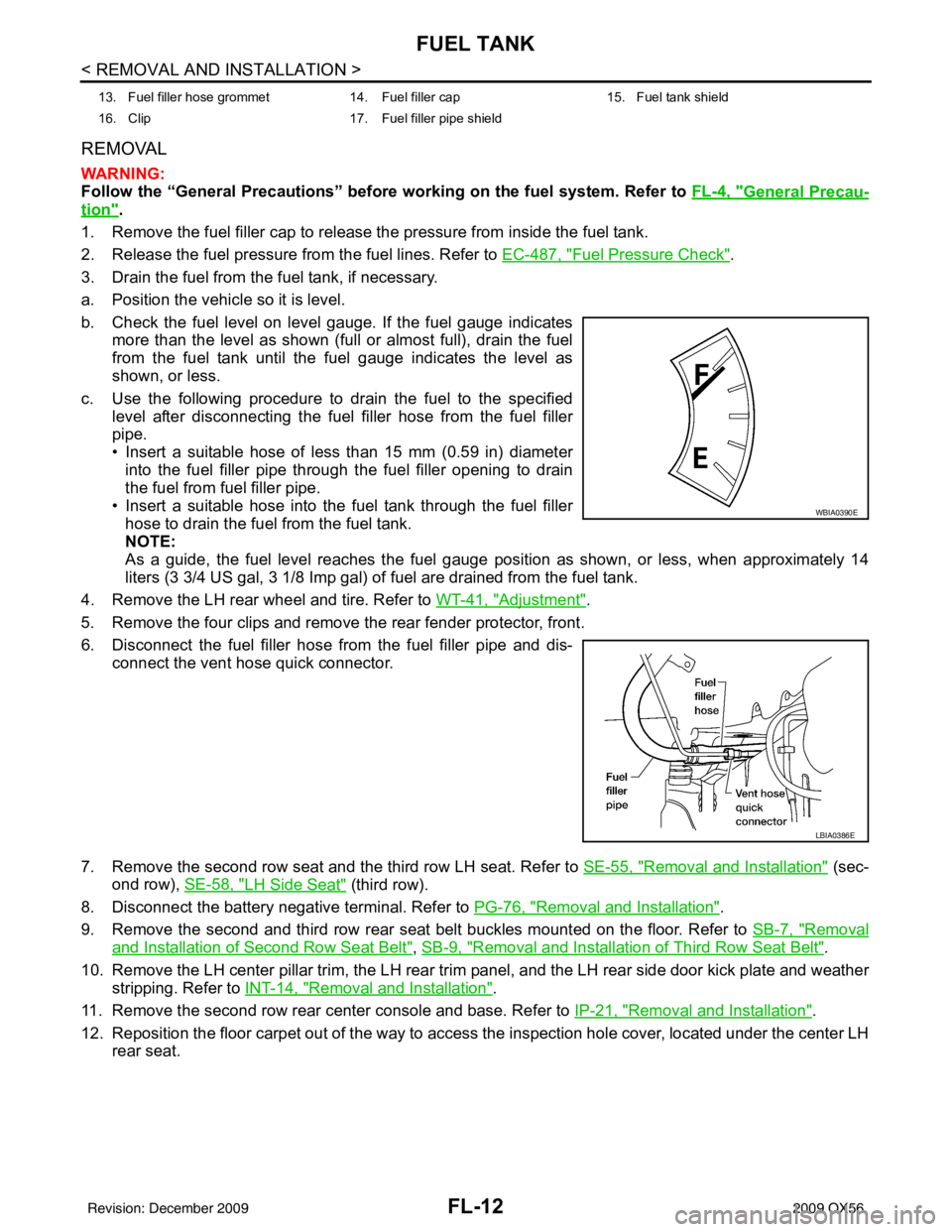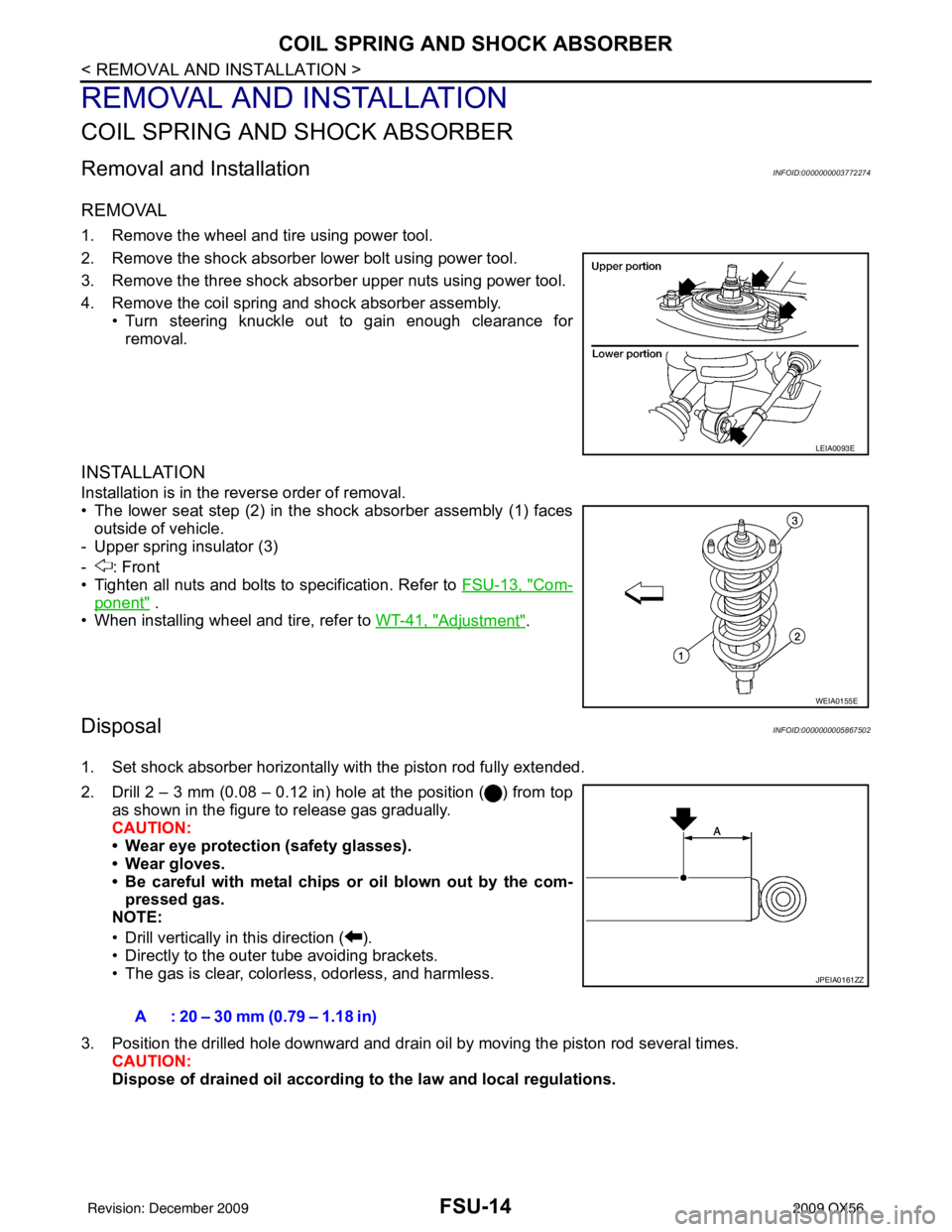seat adjustment INFINITI QX56 2009 Factory User Guide
[x] Cancel search | Manufacturer: INFINITI, Model Year: 2009, Model line: QX56, Model: INFINITI QX56 2009Pages: 4171, PDF Size: 84.65 MB
Page 1268 of 4171
![INFINITI QX56 2009 Factory User Guide
DLN-212
< ON-VEHICLE REPAIR >[FRONT FINAL DRIVE: M205]
FRONT OIL SEAL
8. Remove the front oil seal using Tool as shown.
INSTALLATION
1. Apply multi-purpose grease to the lips of the new front oil sea INFINITI QX56 2009 Factory User Guide
DLN-212
< ON-VEHICLE REPAIR >[FRONT FINAL DRIVE: M205]
FRONT OIL SEAL
8. Remove the front oil seal using Tool as shown.
INSTALLATION
1. Apply multi-purpose grease to the lips of the new front oil sea](/img/42/57031/w960_57031-1267.png)
DLN-212
< ON-VEHICLE REPAIR >[FRONT FINAL DRIVE: M205]
FRONT OIL SEAL
8. Remove the front oil seal using Tool as shown.
INSTALLATION
1. Apply multi-purpose grease to the lips of the new front oil seal.
Then drive the new front oil seal in evenly to the gear carrier
using Tool.
CAUTION:
Do not reuse front oil seal.
Do not incline the new fron t oil seal when installing.
Apply multi-purpose grease to the lips of the new front oil seal.
2. Install the companion flange to the drive pinion while aligning the matching marks.
3. Apply anti-corrosive oil to the threads of the drive pinion and the seating surface of the new drive pinion lock nut. Then adjust the
drive pinion lock nut tightening torque using suitable tool A, and
check the total preload torque using Tool B.
The total preload torque should be within the total preload
torque specification. When not replacing the collapsible
spacer, it should also be equal to the measurement taken dur-
ing removal plus an additional 0.56 N·m (0.06 Kg-m, 5 in-lb).
If the total preload torque is low, tighten the drive pinion lock nut in 6.8 N·m (0.69 Kg-m, 5ft-lb) increments until the total pre-
load torque is met.
CAUTION:
Do not reuse drive pinion lock nut.
Apply anti-corrosive oil to th e threads of the drive pinion
and the seating surface of the new drive pinion lock nut.
Adjust the drive pinion lock nut tightening torque to the
lower limit first. Do not exceed the drive pinion lock nut
specified torque. Refer to DLN-217, "Disassembly and
Assembly".
Do not loosen drive pinion lock nut to adjust the total preload torque. If the drive pinion lock nut
torque or the total preload torque exceeds the sp ecifications, replace the collapsible spacer and
tighten it again to adjust. Refer to DLN-217, "Disassembly and Assembly"
.
After adjustment, rotate drive pinion back and fo rth 2 to 3 times to check for unusual noise, rota-
tion malfunction, and other malfunctions.
4. Installation of the remaining components is in the reverse order of removal. CAUTION:Tool number : SP8P
LDIA0130E
Tool number : KV38100500 (J-25273)
: KV38102200 ( — )
BDIA0003E
Tool number B: ST3127S000 (J-25765-A)
Total preload torque: Refer to DLN-234, "General
Specification".
WDIA0381E
Revision: December 20092009 QX56
Page 1286 of 4171
![INFINITI QX56 2009 Factory User Guide
DLN-230
< DISASSEMBLY AND ASSEMBLY >[FRONT FINAL DRIVE: M205]
FRONT FINAL DRIVE
10. Apply anti-corrosive oil to the threads of the drive pinion and the
seating surface of the new drive pinion lock nu INFINITI QX56 2009 Factory User Guide
DLN-230
< DISASSEMBLY AND ASSEMBLY >[FRONT FINAL DRIVE: M205]
FRONT FINAL DRIVE
10. Apply anti-corrosive oil to the threads of the drive pinion and the
seating surface of the new drive pinion lock nu](/img/42/57031/w960_57031-1285.png)
DLN-230
< DISASSEMBLY AND ASSEMBLY >[FRONT FINAL DRIVE: M205]
FRONT FINAL DRIVE
10. Apply anti-corrosive oil to the threads of the drive pinion and the
seating surface of the new drive pinion lock nut. Then adjust the
drive pinion lock nut tightening torque using suitable tool (A),
and check the drive pinion bearing preload torque using Tool
(B).
CAUTION:
Do not reuse drive pinion lock nut.
Apply anti-corrosive oil to th e threads of the drive pinion
and the seating surface of the new drive pinion lock nut.
Adjust the drive pinion lock nut tightening torque to the lower limit first. Do not exceed the drive pinion lock nut
specified torque. Refer to DLN-217, "Disassembly and
Assembly".
If the drive pinion bearing preload torque exceeds the specified value, replace collap sible spacer and tighten it
again to adjust. Do not lo osen drive pinion lock nut to
adjust the drive pinion bearing preload torque.
After adjustment, rotate drive pinion back and fo rth 2 to 3 times to check for unusual noise, rota-
tion malfunction, and other malfunctions.
11. Check companion flange runout.
12. Install the differential case assembly.
Differential Assembly
1. Install side gear thrust washers with the same thickness as the ones installed prior to disassembly, or reinstall the old ones on
the side gears.
2. Install the side gears and side gear thrust washers into the dif- ferential case.
3. Install the pinion mate thrust washers to the two pinion mate gears. Then install the pinion mate gears with the pinion mate
thrust washers by aligning them in diagonally opposite positions
and rotating them into the differential case.Tool number B: ST3127S000 (J-25765-A)
Drive pinion bearing preload torque
: Refer to DLN-234, "Inspection and Adjust-
ment"
WDIA0382E
SDIA0193J
SDIA2025E
Revision: December 20092009 QX56
Page 1302 of 4171
![INFINITI QX56 2009 Factory User Guide
DLN-246
< ON-VEHICLE REPAIR >[REAR FINAL DRIVE: R230]
FRONT OIL SEAL
1. Apply multi-purpose grease to the lips of the new front oil seal.
Then drive the new front oil seal in evenly until it becomes INFINITI QX56 2009 Factory User Guide
DLN-246
< ON-VEHICLE REPAIR >[REAR FINAL DRIVE: R230]
FRONT OIL SEAL
1. Apply multi-purpose grease to the lips of the new front oil seal.
Then drive the new front oil seal in evenly until it becomes](/img/42/57031/w960_57031-1301.png)
DLN-246
< ON-VEHICLE REPAIR >[REAR FINAL DRIVE: R230]
FRONT OIL SEAL
1. Apply multi-purpose grease to the lips of the new front oil seal.
Then drive the new front oil seal in evenly until it becomes flush
with the gear carrier using Tool.
CAUTION:
Do not reuse front oil seal.
Do not incline the new fron t oil seal when installing.
Apply multi-purpose grease to the lips of the new front oil
seal.
2. Install the companion flange to the drive pinion while aligning the matching marks.
3. Apply anti-corrosive oil to the threads of the drive pinion and the seating surface of the new drive pinion lock nut. Then adjust the
drive pinion lock nut tightening torque using suitable tool (A),
and check the total preload torque using Tool (B).
The total preload torque should be within the total preloadtorque specification. When not replacing the collapsible
spacer, it should also be equal to the measurement taken dur-
ing removal plus an additional 0.56 N·m (0.06 Kg-m, 5 in-lb).
If the total preload torque is low, tighten the drive pinion lock nut in 6.8 N·m (0.69 Kg-m, 5ft-lb) increments until the total pre-
load torque is met.
CAUTION:
Do not reuse drive pinion lock nut.
Apply anti-corrosive oil to th e threads of the drive pinion
and the seating surface of the new drive pinion lock nut.
Adjust the drive pinion lock nut tightening torque to the
lower limit first. Do not exceed the drive pinion lock nut
specified torque. Refer to DLN-253, "Disassembly and
Assembly".
Do not loosen drive pinion lock nu t to adjust the total preload torque. If the total preload torque
exceeds the specifications, replace the collapsible sp acer and tighten it again to adjust. Refer to
DLN-253, "Disassembly and Assembly"
.
After adjustment, rotate drive pinion back and fo rth 2 to 3 times to check for unusual noise, rota-
tion malfunction, and other malfunctions.
4. Installation of the remaining components is in the reverse order of removal. CAUTION:
Check the differential gear oil level after installation. Refer to DLN-244, "Checking Differential Gear
Oil".
Tool number : ST15310000 ( — )
PDIA0565E
Tool number B: ST3127S000 (J-25765-A)
Total preload torque: Refer to
DLN-253, "Disassem-
bly and Assembly".
WDIA0380E
Revision: December 20092009 QX56
Page 1319 of 4171
![INFINITI QX56 2009 Factory User Guide
REAR FINAL DRIVEDLN-263
< DISASSEMBLY AND ASSEMBLY > [REAR FINAL DRIVE: R230]
C
EF
G H
I
J
K L
M A
B
DLN
N
O P
1. Apply differential gear oil to the side bearings, and install the dif- ferential case INFINITI QX56 2009 Factory User Guide
REAR FINAL DRIVEDLN-263
< DISASSEMBLY AND ASSEMBLY > [REAR FINAL DRIVE: R230]
C
EF
G H
I
J
K L
M A
B
DLN
N
O P
1. Apply differential gear oil to the side bearings, and install the dif- ferential case](/img/42/57031/w960_57031-1318.png)
REAR FINAL DRIVEDLN-263
< DISASSEMBLY AND ASSEMBLY > [REAR FINAL DRIVE: R230]
C
EF
G H
I
J
K L
M A
B
DLN
N
O P
1. Apply differential gear oil to the side bearings, and install the dif- ferential case assembly with the side bearing outer races into
the gear carrier.
CAUTION:
Do not reuse side bearing ou ter race when replacing side
bearing inner race (replace as a set).
2. Insert the left and right original side bearing adjusting washers in place between side bearings and gear carrier.
3. Align the matching mark on the side bearing cap with the match- ing mark on the gear carrier.
4. Install the side bearing caps and tighten the side bearing cap bolts to the specified torque.
5. Turn the differential assembly several times to seat the side bearings.
6. To determine side bearing preload torque, measure the pulling force of the differential assemb ly at the drive gear bolt using
Tool.
NOTE:
If pulling force of the differential assembly at the drive gear bolt
is within specification, side bearing preload torque will also be
within specification. Refer to DLN-270, "Inspection and Adjustment"
.
SPD527
SPD924
SDIA1795E
Tool number : — (J-8129)
Specification : Refer to DLN-270, "Inspection and
Adjustment"
SPD194A
Revision: December 20092009 QX56
Page 1322 of 4171
![INFINITI QX56 2009 Factory User Guide
DLN-266
< DISASSEMBLY AND ASSEMBLY >[REAR FINAL DRIVE: R230]
REAR FINAL DRIVE
10. Apply anti-corrosive oil to the threads of the drive pinion and the
seating surface of the new drive pinion lock nut. INFINITI QX56 2009 Factory User Guide
DLN-266
< DISASSEMBLY AND ASSEMBLY >[REAR FINAL DRIVE: R230]
REAR FINAL DRIVE
10. Apply anti-corrosive oil to the threads of the drive pinion and the
seating surface of the new drive pinion lock nut.](/img/42/57031/w960_57031-1321.png)
DLN-266
< DISASSEMBLY AND ASSEMBLY >[REAR FINAL DRIVE: R230]
REAR FINAL DRIVE
10. Apply anti-corrosive oil to the threads of the drive pinion and the
seating surface of the new drive pinion lock nut. Then adjust the
drive pinion lock nut tightening torque using suitable tool (A),
and check the drive pinion bearing preload torque using Tool
(B).
CAUTION:
Do not reuse drive pinion lock nut.
Apply anti-corrosive oil to th e threads of the drive pinion
and the seating surface of the new drive pinion lock nut.
Adjust the drive pinion lock nut tightening torque to the lower limit first. Do not exceed the drive pinion lock nut
specified torque.
If the drive pinion bearing preload torque exceeds the specified value, replace collap sible spacer and tighten it
again to adjust. Do not lo osen drive pinion lock nut to
adjust the drive pinion bearing preload torque.
After adjustment, rotate dri ve pinion back and forth 2 to 3
times to check for unusual no ise, rotation malfunction,
and other malfunctions.
11. Check companion flange runout.
12. Install the differential case assembly.
Differential Assembly
1. Install side gear thrust washers with the same thickness as the ones installed prior to disassembly, or reinstall the old ones on
the side gears.
2. Install the side gears and side gear thrust washers into the dif- ferential case.
CAUTION:
Make sure that the circular clip is installed to side gears.
3. Install the pinion mate thrust washers to the two pinion mate gears. Then install the pinion mate gears with the pinion mate
thrust washers by aligning them in diagonally opposite positions
and rotating them into the differential case.Tool number B: ST3127S000 (J-25765-A)
Drive pinion bearing preload torque
: Refer to DLN-270, "Inspection and Adjustment"
WDIA0379E
SDIA0193J
SDIA2025E
Revision: December 20092009 QX56
Page 1951 of 4171

EXL-3
C
DE
F
G H
I
J
K
M A
B
EXL
N
O P
Diagnosis Procedure ...........................................
..
139
BOTH SIDE FRONT FOG LAMPS ARE NOT
TURNED ON .....................................................
140
Description ............................................................140
Diagnosis Procedure .............................................140
PRECAUTION ............................................141
PRECAUTIONS .............................................. ..141
Precaution for Supplemental Restraint System
(SRS) "AIR BAG" and "SEAT BELT PRE-TEN-
SIONER" ............................................................. ..
141
Precaution Necessary for Steering Wheel Rota-
tion After Battery Disconnect ............................... ..
141
General precautions for service operations ..........142
ON-VEHICLE REPAIR .... ...........................143
ADJUSTMENT AND INSPECTION ................ ..143
HEADLAMP ........................................................... ..143
HEADLAMP : Aiming Adjustment .........................143
FRONT FOG LAMP ............................................... ..144
FRONT FOG LAMP : Aiming Adjustment .............144
REMOVAL AND INSTALLATION .............146
HEADLAMP .................................................... ..146
Bulb Replacement .................................................146
Removal and Installation .......................................147
Disassembly and Assembly ................................ ..147
AUTO LIGHT SYSTEM ....................................149
Removal and Installation ..................................... ..149
FRONT FOG LAMP ........................................150
Bulb Replacement .................................................150
Removal and Installation .......................................150
LIGHTING & TURN SIGNAL SWITCH ...........152
Removal and Installation .......................................152
HAZARD SWITCH ..........................................153
Removal and Installation .......................................153
PUDDLE LAMP ...............................................154
Removal and Installation .......................................154
Bulb Replacement .................................................154
LICENSE PLATE LAMP .................................155
Bulb Replacement .................................................155
Removal and Installation .......................................155
STOP LAMP ....................................................156
Bulb Replacement .................................................156
Removal and Installation .......................................156
REAR COMBINATION LAMP .........................157
Bulb Replacement .................................................157
Removal and Installation .......................................157
SERVICE DATA AND SPECIFICATIONS
(SDS) ............... .......................................... .
158
BULB SPECIFICATIONS ................................158
Headlamp ............................................................ ..158
Exterior Lamp ........................................................158
Revision: December 20092009 QX56
Page 2093 of 4171

ADJUSTMENT AND INSPECTIONEXL-145
< ON-VEHICLE REPAIR >
C
DE
F
G H
I
J
K
M A
B
EXL
N
O P
• See that vehicle is unloaded (except for full levels of coolant, engine oil and fuel, and spare tire, jack, and tools). Have the driver
or equivalent weight placed in driver seat.
Adjust aiming in the vertical direction by turning the adjustment
screw.
NOTE:
Access adjustment screw from underneath front bumper. Turn screw
clockwise to raise pattern and c ounterclockwise to lower pattern.
1. Set the distance between the screen and the center of the fog lamp lens as shown.
2. Turn front fog lamps ON.
3. Adjust front fog lamps using adjusting screw so that the top edge of the high intensity zone is 200 mm (7.9 in) below the height of
the fog lamp centers as shown.
• When performing adjustment, if necessary, cover the head-lamps and opposite fog lamp.
SEL350X
MEL327G
MEL328GA
Revision: December 20092009 QX56
Page 2114 of 4171

EXT-8
< SERVICE INFORMATION >
SQUEAK AND RATTLE TROUBLE DIAGNOSES
Most of these incidents can be repaired by adjusting, securing or insulating the item(s) or component(s) caus-
ing the noise.
SUNROOF/HEADLINING
Noises in the sunroof/headlining area c an often be traced to one of the following:
1. Sunroof lid, rail, linkage or seals making a rattle or light knocking noise
2. Sun visor shaft shaking in the holder
3. Front or rear windshield touching headliner and squeaking
Again, pressing on the components to stop the noise while duplicating the conditions can isolate most of these
incidents. Repairs usually consist of insulating with felt cloth tape.
OVERHEAD CONSOLE (FRONT AND REAR)
Overhead console noises are often caused by the c onsole panel clips not being engaged correctly. Most of
these incidents are repaired by pushing up on the c onsole at the clip locations until the clips engage.
In addition look for:
1. Loose harness or harness connectors.
2. Front console map/reading lamp lens loose.
3. Loose screws at console attachment points.
SEATS
When isolating seat noise it's important to note the pos ition the seat is in and the load placed on the seat when
the noise is present. These conditions should be duplicated when verifying and isolating the cause of the
noise.
Cause of seat noise include:
1. Headrest rods and holder
2. A squeak between the seat pad cushion and frame
3. The rear seatback lock and bracket
These noises can be isolated by moving or pressing on the suspected components while duplicating the con-
ditions under which the noise occurs. Most of thes e incidents can be repaired by repositioning the component
or applying urethane tape to the contact area.
UNDERHOOD
Some interior noise may be caused by components under the hood or on the engine wall. The noise is then
transmitted into the passenger compartment.
Causes of transmitted underhood noise include:
1. Any component installed to the engine wall
2. Components that pass through the engine wall
3. Engine wall mounts and connectors
4. Loose radiator installation pins
5. Hood bumpers out of adjustment
6. Hood striker out of adjustment
These noises can be difficult to isolate since they cannot be reached from the interior of the vehicle. The best
method is to secure, move or insulate one component at a time and test drive the \
vehicle. Also, engine RPM
or load can be changed to isolate the noise. Repairs can usually be made by moving, adjusting, securing, or
insulating the component causing the noise.
Revision: December 20092009 QX56
Page 2165 of 4171

FL-12
< REMOVAL AND INSTALLATION >
FUEL TANK
REMOVAL
WARNING:
Follow the “General Precautions” before working on the fuel system. Refer to FL-4, "
General Precau-
tion".
1. Remove the fuel filler cap to release the pressure from inside the fuel tank.
2. Release the fuel pressure from the fuel lines. Refer to EC-487, "
Fuel Pressure Check".
3. Drain the fuel from the fuel tank, if necessary.
a. Position the vehicle so it is level.
b. Check the fuel level on level gauge. If the fuel gauge indicates more than the level as shown (full or almost full), drain the fuel
from the fuel tank until the fuel gauge indicates the level as
shown, or less.
c. Use the following procedure to drain the fuel to the specified level after disconnecting the fuel filler hose from the fuel filler
pipe.
• Insert a suitable hose of less than 15 mm (0.59 in) diameterinto the fuel filler pipe through the fuel filler opening to drain
the fuel from fuel filler pipe.
• Insert a suitable hose into the fuel tank through the fuel filler hose to drain the fuel from the fuel tank.
NOTE:
As a guide, the fuel level reaches the fuel gauge position as shown, or less, when approximately 14
liters (3 3/4 US gal, 3 1/8 Imp gal) of fuel are drained from the fuel tank.
4. Remove the LH rear wheel and tire. Refer to WT-41, "
Adjustment".
5. Remove the four clips and remove the rear fender protector, front.
6. Disconnect the fuel filler hose from the fuel filler pipe and dis- connect the vent hose quick connector.
7. Remove the second row seat and the third row LH seat. Refer to SE-55, "
Removal and Installation" (sec-
ond row), SE-58, "
LH Side Seat" (third row).
8. Disconnect the battery negative terminal. Refer to PG-76, "
Removal and Installation".
9. Remove the second and third row rear seat belt buckles mounted on the floor. Refer to SB-7, "
Removal
and Installation of Second Row Seat Belt", SB-9, "Removal and Installation of Third Row Seat Belt".
10. Remove the LH center pillar trim, the LH rear trim panel, and the LH rear side door kick plate and weather
stripping. Refer to INT-14, "
Removal and Installation".
11. Remove the second row rear center console and base. Refer to IP-21, "
Removal and Installation".
12. Reposition the floor carpet out of the way to access the inspection hole cover, located under the center LH
rear seat.
13. Fuel filler hose grommet 14. Fuel filler cap 15. Fuel tank shield
16. Clip 17. Fuel filler pipe shield
WBIA0390E
LBIA0386E
Revision: December 20092009 QX56
Page 2184 of 4171

FSU-14
< REMOVAL AND INSTALLATION >
COIL SPRING AND SHOCK ABSORBER
REMOVAL AND INSTALLATION
COIL SPRING AND SHOCK ABSORBER
Removal and InstallationINFOID:0000000003772274
REMOVAL
1. Remove the wheel and tire using power tool.
2. Remove the shock absorber lower bolt using power tool.
3. Remove the three shock absorber upper nuts using power tool.
4. Remove the coil spring and shock absorber assembly.• Turn steering knuckle out to gain enough clearance forremoval.
INSTALLATION
Installation is in the reverse order of removal.
• The lower seat step (2) in the shock absorber assembly (1) faces
outside of vehicle.
- Upper spring insulator (3)
- : Front
• Tighten all nuts and bolts to specification. Refer to FSU-13, "
Com-
ponent" .
• When installing wheel and tire, refer to WT-41, "
Adjustment".
DisposalINFOID:0000000005867502
1. Set shock absorber horizontally with the piston rod fully extended.
2. Drill 2 – 3 mm (0.08 – 0.12 in) hole at the position ( ) from top
as shown in the figure to release gas gradually.
CAUTION:
• Wear eye protection (safety glasses).
• Wear gloves.
• Be careful with metal chips or oil blown out by the com-pressed gas.
NOTE:
• Drill vertically in this direction ( ).
• Directly to the outer tube avoiding brackets.
• The gas is clear, colorless, odorless, and harmless.
3. Position the drilled hole downward and drain oil by moving the piston rod several times. CAUTION:
Dispose of drained oil according to the law and local regulations.
LEIA0093E
WEIA0155E
A : 20 – 30 mm (0.79 – 1.18 in)
JPEIA0161ZZ
Revision: December 20092009 QX56